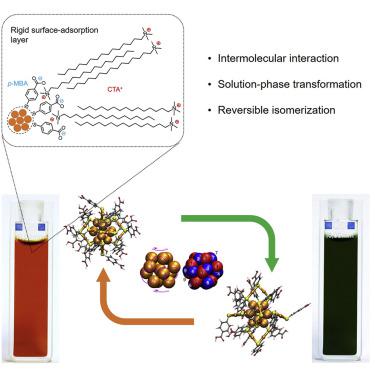Chem ( IF 19.1 ) Pub Date : 2021-07-16 , DOI: 10.1016/j.chempr.2021.06.023 Yitao Cao 1 , Sami Malola 2 , María Francisca Matus 2 , Tiankai Chen 1 , Qiaofeng Yao 1 , Run Shi 3 , Hannu Häkkinen 2 , Jianping Xie 1, 4

|
Most inorganic nanoparticles are directly surface terminated (and stabilized) by protecting ligands, which could greatly affect the atomic packing and physical/chemical properties of their inorganic cores. Here, we show that the intermolecular interactions between the adsorbed molecules and surface ligands can also affect the core structure of inorganic nanoparticles. Through the coupling/decoupling of cationic surfactants (cetyltrimethylammonium cations, CTA+) and anionic surface ligands (para-mercaptobenzoic acid, p-MBA) in the aqueous phase, we have achieved a reversible transformation between two isomers of [Au25(p-MBA)18]− nanoclusters. The interconversion process between the two isomers shows the characteristics of a reversible nanocluster isomerization process. The two isomers are topologically connected via a simple rotation of the gold core without breaking any Au-S bonds at the metal-ligand interface. The adsorbed CTA+ cations would interact with the p-MBA layer through the CH∙∙∙π interaction and stabilize the more open ligand shell of the new isomer in the forward isomerization process.
中文翻译:

分子间相互作用诱导金属纳米团簇的可逆异构化
大多数无机纳米粒子通过保护配体直接封端(并稳定),这会极大地影响其无机核的原子堆积和物理/化学性质。在这里,我们表明吸附分子和表面配体之间的分子间相互作用也会影响无机纳米粒子的核心结构。通过阳离子表面活性剂(十六烷基三甲基铵阳离子,CTA +)和阴离子表面配体(对巯基苯甲酸,p- MBA)在水相中的偶联/去偶联,我们实现了[Au 25 ( p- MBA) 18 ] -纳米团簇。两种异构体之间的相互转化过程显示了可逆纳米团簇异构化过程的特征。这两种异构体通过金核的简单旋转进行拓扑连接,而不会破坏金属-配体界面处的任何 Au-S 键。吸附的 CTA +阳离子将通过 CH∙∙∙π 相互作用与p- MBA 层相互作用,并在正向异构化过程中稳定新异构体的更开放的配体壳。











































 京公网安备 11010802027423号
京公网安备 11010802027423号